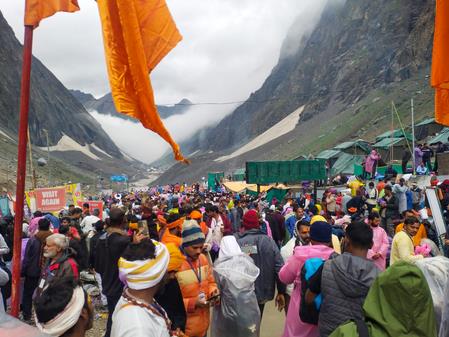
Amarnath Yatra Suspended From Today, A Week Before Scheduled End
Authorities cited persistent adverse weather conditions and the deteriorating condition of the Yatra tracks as the main reasons behind the early closure.
The pilgrimage had already been temporarily halted three days ago due to heavy rainfall in the region.
On Saturday, officials announced that the Yatra would not resume from either of the two traditional routes, Baltal or Pahalgam, due to the unsafe condition of the tracks and the need for urgent repair work.
According to Divisional Commissioner Kashmir, Vijay Kumar Bidhuri, the terrain has been severely affected by recent downpours, rendering the route unsafe for pilgrims. He stated that both routes required immediate repair and maintenance, and continuing the Yatra while deploying men and machinery for those repairs was not feasible.
Despite the premature conclusion, around four lakh pilgrims managed to visit the revered cave shrine this year, according to figures from the Shri Amarnath Shrine Board. However, officials acknowledged that the number of pilgrims had sharply declined in the past week, likely due to weather-related disruptions.
Security for this year's Yatra was heightened significantly in the wake of a major terror attack in Pahalgam on April 22. The government deployed over 600 additional paramilitary companies in addition to existing forces, making it one of the most heavily guarded pilgrimages in the country.
Pilgrims were moved in tightly monitored convoys from Jammu to the twin base camps, and civilian movement was halted during convoy hours along the Srinagar-Jammu National Highway.
The Amarnath Yatra, which traces its roots to the discovery of the cave in the 1850s by a Muslim shepherd named Bota Malik, has historically been seen as a symbol of Kashmir's syncretic culture.
Until 2005, the Malik family was responsible for organising the pilgrimage before the Shri Amarnath Shrine Board took over. However, recent years have seen reduced interaction between yatris and the local population, as stringent security arrangements have confined most pilgrims within heavily guarded enclosures. Residents note that only those directly involved in the Yatra, such as pony handlers and palanquin bearers, still maintain regular contact with the pilgrims.

Legal Disclaimer:
MENAFN provides the
information “as is” without warranty of any kind. We do not accept
any responsibility or liability for the accuracy, content, images,
videos, licenses, completeness, legality, or reliability of the information
contained in this article. If you have any complaints or copyright
issues related to this article, kindly contact the provider above.
















Comments
No comment